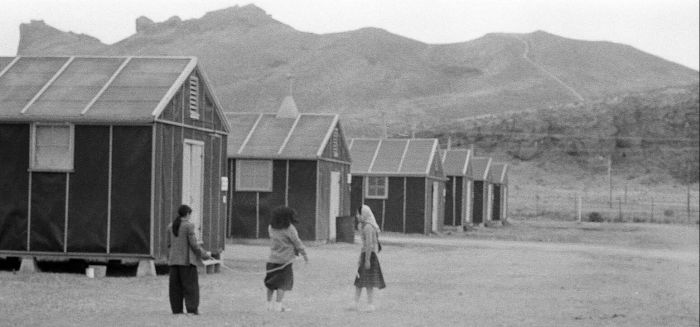Connections and distinctions farewell to manzanar note-catcher – In Farewell to Manzanar, Jeanne Wakatsuki Houston explores the complex connections and distinctions that shape human experience, particularly during times of adversity. Through the lens of the Japanese American internment during World War II, the novel examines the resilience of the human spirit and the enduring power of memory.
The novel’s protagonist, Jeanne, serves as a note-catcher, documenting the experiences and emotions of her family and fellow internees. Through her keen observations, Houston weaves a rich tapestry of personal stories that illuminate the profound impact of Manzanar on individuals and communities.
Connections and Distinctions in Farewell to Manzanar

Jeanne Wakatsuki Houston’s Farewell to Manzanarexplores the theme of connections between people in various ways. The novel highlights the strong bonds that form between the Japanese Americans who are forced to live in the Manzanar internment camp during World War II. These characters find solace and support in one another as they face the hardships and injustices of their situation.
The novel also examines the connections between the Japanese Americans and the white Americans who work at the camp. While some of these relationships are strained by prejudice and mistrust, others are characterized by compassion and understanding. These connections serve to highlight the complexities of human nature and the ways in which people can overcome adversity.
The setting of the novel plays a significant role in shaping the characters’ connections to each other and to their surroundings. The harsh conditions of the camp force the characters to rely on one another for survival. They must learn to work together and support each other in order to make the best of their difficult situation.
Note-Catcher as a Symbol
The note-catcher in the novel is a powerful symbol of the characters’ memories and experiences. The note-catcher is a small wooden box that Jeanne’s father makes for her to hold the notes she writes about her experiences in Manzanar. The notes serve as a way for Jeanne to record and preserve her memories of this difficult time in her life.
The note-catcher also represents the characters’ hope and resilience. Despite the hardships they face, the characters in the novel are determined to maintain their hope for a better future. The note-catcher serves as a reminder of this hope and the characters’ determination to overcome adversity.
The Impact of Manzanar on the Characters
The physical and emotional impact of Manzanar on the characters in the novel is profound. The characters are forced to live in cramped and unsanitary conditions, and they are subjected to discrimination and prejudice from the white Americans who work at the camp.
The characters’ experiences in Manzanar shape their identities and their relationships with others. They learn to rely on one another for support, and they develop a strong sense of community. However, they also experience trauma and loss, and they are left with lasting scars from their time in the camp.
The Historical Context of Farewell to Manzanar
Farewell to Manzanaris set against the backdrop of the Japanese American internment during World War II. The novel provides a valuable historical perspective on this dark chapter in American history. The novel helps to raise awareness of the injustices that were committed against Japanese Americans during this time, and it contributes to our understanding of the lasting impact of racism and prejudice.
Literary Devices in Farewell to Manzanar
Jeanne Wakatsuki Houston uses a variety of literary devices in Farewell to Manzanarto create a vivid and impactful story. These devices include symbolism, imagery, and foreshadowing.
Symbolism is used throughout the novel to represent the characters’ experiences and emotions. For example, the note-catcher symbolizes the characters’ memories and hope. Imagery is used to create a vivid picture of the setting and the characters’ experiences. For example, Houston uses imagery to describe the harsh conditions of the camp and the characters’ struggles to survive.
Foreshadowing is used to hint at events that will happen later in the novel. For example, Houston uses foreshadowing to hint at the eventual release of the characters from the camp.
Reception and Legacy of Farewell to Manzanar, Connections and distinctions farewell to manzanar note-catcher
Farewell to Manzanarwas met with critical acclaim upon its release. The novel was praised for its powerful storytelling and its insights into the Japanese American experience during World War II. The novel has been translated into over 20 languages and has been adapted into a television movie and a play.
Farewell to Manzanarhas had a lasting impact on American literature and culture. The novel has helped to raise awareness of the Japanese American internment and its impact on the lives of those who were affected by it. The novel has also been praised for its literary merit, and it is considered to be one of the most important works of Asian American literature.
Expert Answers: Connections And Distinctions Farewell To Manzanar Note-catcher
What is the significance of the note-catcher in Farewell to Manzanar?
The note-catcher represents the act of preserving memories and experiences, particularly those that are often marginalized or forgotten. Jeanne’s role as a note-catcher ensures that the stories of the internees are not lost to history.
How does the setting of Manzanar shape the characters’ experiences?
Manzanar’s harsh and isolated environment tests the characters’ physical and emotional resilience. The constant surveillance and deprivation create a sense of uncertainty and fear, while the close quarters foster both camaraderie and conflict.
What is the lasting impact of Manzanar on the characters?
Manzanar leaves an indelible mark on the characters’ identities and relationships. The trauma they endure shapes their perspectives on life, their sense of belonging, and their ability to trust others.

